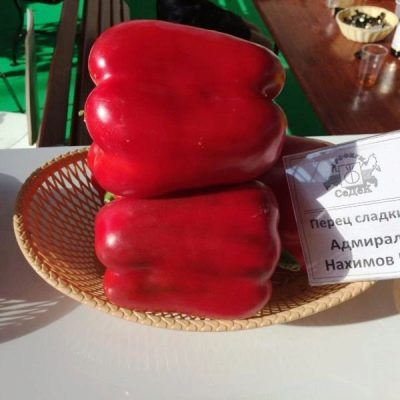
- Authors: Lukyanenko A.N., Dubinin S.V., Dubinina I.N.
- Year of approval: 2017
- Bush height, cm: 80-90
- Growth type: medium-sized
- Fruit shape: cuboid
- Fruit weight, g: 250-350
- Fruit color: green in technical ripeness, bright red in biological ripeness
- Ripening terms: mid-season
- Ripening month: from June to August
- Fruit size, cm: 15 x 8
Admiral Nakhimov is a sweet bell pepper variety bred by Russian breeders and approved for use in 2017. For such a short period of time, many gardeners have already sang the variety to try to grow, based on whose experience we will get to know this variety better.
Description of the variety
The presented variety has a high yield, as well as the possibility of planting both in a greenhouse and in open ground. The advantages include the high marketability of the fruits, they can be stored for a long time, and are also suitable for long-term transportation. This variety also has several disadvantages. So, a powerful bush requires an obligatory garter to a support, and the fruits have very dense walls, which can become an obstacle to the preparation of a vegetable vitamin salad.
Characteristics of the appearance of plants and fruits
The bush has an average vigor of growth, its height reaches 80-90 cm. It has large dark green, slightly wrinkled leaves, the fruits develop in a drooping position. The peppers are formed large, 15x8 cm in size and weighing 250-350 g, cuboid in shape, bright red in color. The skin is smooth, glossy, has walls with a density of 8-9 mm, 3 or 4 chambers are formed inside.
Purpose and taste
The pulp of the pepper is very juicy, sweet, has a bright peppery aroma. The fruits can be eaten fresh, used for stewing and making sauces, as well as canned and frozen.
Ripening terms
The fruiting period is usually June-August. By the beginning of the appearance of the first fruits, the bushes are already at the age of 115-120 days from the moment of their emergence. Consequently, Admiral Nakhimov belongs to varieties with a mid-season ripening period.
Yield
This is a high-yielding variety, but the yield depends on the conditions of agricultural technology. So, in the open field, you can get 40-55 tons from each hectare, and when grown in a greenhouse, the gardener will be able to collect about 8-9.5 kg of vegetables from each square meter.
Landing scheme
Sowing is carried out in mid-February. The seeds are buried at a level of 1.5 cm and the container is covered with foil. When seedlings appear, the container is placed in a lighted place, further care is reduced to watering and maintaining the temperature of + 22 ... +25 degrees. When leaves appear, the seedlings dive, and 10 days before the expected date of transplantation, they begin to harden, that is, take them out into the fresh air every day.
Transplanting into open ground usually occurs in June, and bushes can be planted under a film or in a greenhouse in mid-May. For planting, choose an area with light soil, located in the sun or in partial shade - in such conditions, the culture of the presented variety will feel comfortable and actively develop. Plant the bushes in a 50x70 cm pattern.

To get a large and tasty harvest of pepper, you need to take care of the seedlings in advance. When growing pepper seedlings, you need to correctly determine the sowing time, pre-sowing seed treatment, prepare the necessary container and soil.
Growing and caring
Now, in anticipation of the harvest, the gardener needs to regularly water the ridge and feed the plant with mineral organic fertilizers every two weeks, the bushes respond well to chicken droppings. Also, do not forget to loosen the soil after watering, weed out and tie the main stem to the support.

To harvest a tasty and rich harvest of pepper, you need to comply with all the conditions of agricultural technology, and proper care begins with planting plants. Before planting pepper in open ground, it should be prepared. It is also important to take care of the seedlings and planting space in advance.




For good growth of pepper bushes and active fruiting, you need to regularly apply mineral and organic fertilizing to the soil. It is necessary not only to choose the right formulations, but also to use them at the right stage in the development of culture. The frequency of top dressing is always individual. It depends directly on the composition of the land on your site. The poorer the soil composition, the more often you will need to feed the pepper.
Disease and pest resistance
This variety is highly resistant to diseases and insects, it is almost invulnerable even against such common ailments as the tobacco mosaic virus and verticillary wilting. However, if certain growing conditions are not observed, the culture can be affected by aphids; treatment with a solution of wood ash helps from this individual. Also, the plant can become a victim of a spider mite - in this case, tincture of garlic, onion and dandelion leaves will help.
In order to prevent the attack of pests and prevent rare diseases, keep the area clean, monitor the humidity and temperature in the greenhouse, regularly inspect the bushes for parasites, and water the crop sparingly.

Pepper is one of the most common vegetables in home gardens. This culture is quite stable and unpretentious. However, under certain conditions, this plant can suffer from infections and harmful insects. Before treating peppers for diseases or pests, you need to find out the cause of the problem, otherwise the treatment may be ineffective.





















































































